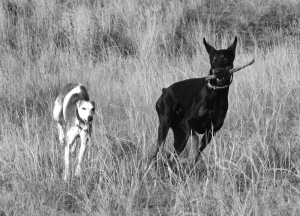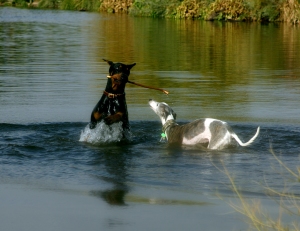Intervertebral Disk Disease (IVDD) in Dogs

Back pain is a common presenting complaint, and working in the ER, I see the full spectrum of signs, from reports of pets “just acting off,†to complete loss of function in the rear legs. The wide spectrum of clinical signs that can be seen depends upon many factors, including location and type of disk disease, the velocity of disk contact with the spinal cord, and the amount and duration of spinal cord compression.
First, some quick anatomy: the spine is composed of multiple bones, called vertebrae, with disks “smushed in between†to provide cushion, acting as the spine’s shock absorbers. Each one of these disks is made up of a gel-like area in the center and a tough fiber-like outer ring (think of a jelly-filled donut). Disease occurs when there are degenerative changes in the disks, causing them to protrude into the spinal canal, causing pressure on the spinal cord itself. This is often referred to as a “slipped disk.â€
There are two types of slipped disks: sudden disk herniation is known as Hansen type I, and chronic (or slow) disk herniation is known as Hansen type II. Type I disease tends to be very sudden and often happens during vigorous activity. Type II disease has a subtler onset and generally worsens over time; this is the most common form of disease and likely the type that most of you experience with your aging pet.
Breeds with short little legs that bow to some degree (such as Pekingese, shih tzu, and dachshund) tend to fall into the Hansen type I category. Larger breeds (such as Labradors and Shepherds) generally tend to have type II, which carries a better prognosis. Type I disease generally affects dogs between the ages of 3-6 years, while type II usually occurs between the ages of 8-10 years.
There are 4 classes of disk disease and they include:
Class 1: back pain only; there is a reluctance to move or jump and hunched posture, quiet behavior, and often a finicky appetite (a common reason for a veterinary visit)
Class 2: back pain with a wobbly or incoordinated gait and mild weakness in the hind limbs; they are still able to walk
Class 3: presence of “proprioceptive deficits†which basically means the brain doesn’t know where the feet are; if you turn your dog’s paw over on its knuckles, it will quickly flip it back over, but with spinal compromise, the brain doesn’t realize the paw is “upside down†and they leave it that way; other times, “scissoring†of the back legs when they attempt to walk is observed; in all of these classes, the front limbs generally remain normal
Class 4: complete loss of function of the back legs (paralysis) but they can still feel their toes when you pinch them; pet owners will often observe their pets dragging themselves around by their front legs
Class 5: complete paralysis with loss of pain sensation
Treatment recommendations depend on the class of disease and are as follows:
Class 1: treated medically with anti inflammatory medications, pain medications, muscle relaxants and REST!! Acupunture, weight loss, hydrotherapy and physical therapy can be added in to further promote back health
Class 2: also treated medically but with close monitoring for any neurological changes or decline followed by surgery if there is worsening of signs. Confinement to a crate for 4 weeks is often recommended.
Classes 3 and 4: surgery is needed to “debulk†the disk material that is pushing on the spinal cord; if surgery is not an option, your veterinarian may still recommend the above treatments for class 1 and 2 because there is always hope that with time, rest, and medications that the inflammation wil decrease
Class 5: surgery is needed within (ideally) the first 8 hours to give the best chance for return of function; if surgery is not an option, mobility carts are useful in many pets and they can continue to have an excellent quality of life
Most dogs in classes 1-4 have a good to excellent prognosis and are able to continue to walk and have a good quality of life. Those pets that are treated conservatively with rest and medications only (no surgery) may experience a return of signs. Pets that fall into class 5 and have surgery have a poorer, but not hopeless prognosis.
This is a subject that hits close to home as my own dog, Emmy Lou (pictured with my other boy, Bauer), suffered from type I, class 5 disease. I had to make the decision to euthanize her after 1 month when she did not regain the use of her hind legs. It happened during playtime when I was throwing the ball for her in the back yard; she suddenly yelped out mid-chase and fell over in pain. I realized that she could not feel her toes and rushed her in for an emergency myelogram, MRI and spinal surgery. The MRI revealed that the gel of her disk essentially “blew through†her spinal cord, nearly completely severing it. Despite her surgery, physical therapy and acupuncture she never did regain use of her hind legs, and being a Whippet, her body didn’t adapt well to a mobility cart. Despite being given a less than 5% chance of recovery, I never regretted the decisions I made for her. Luckily now, with my 100-pound boy, Bauer, I only have to worry about type II disease and be prepared to manage mild degenerative changes he may experience as he approaches 10 years of age.

没有评论:
发表评论